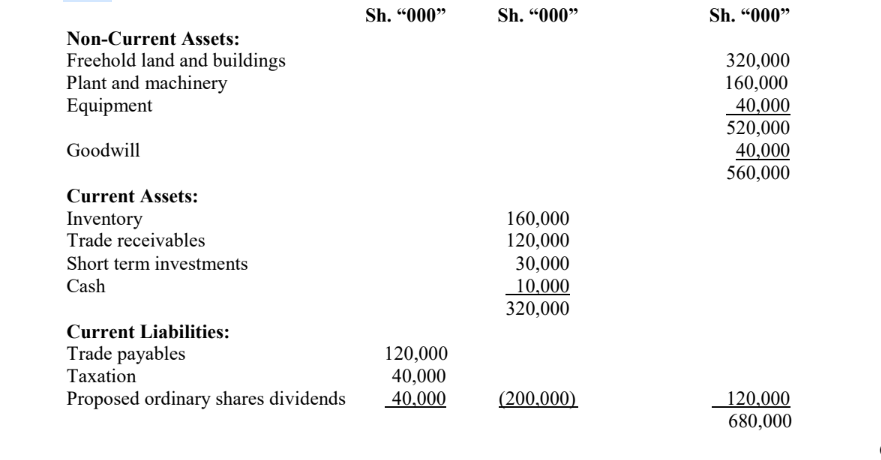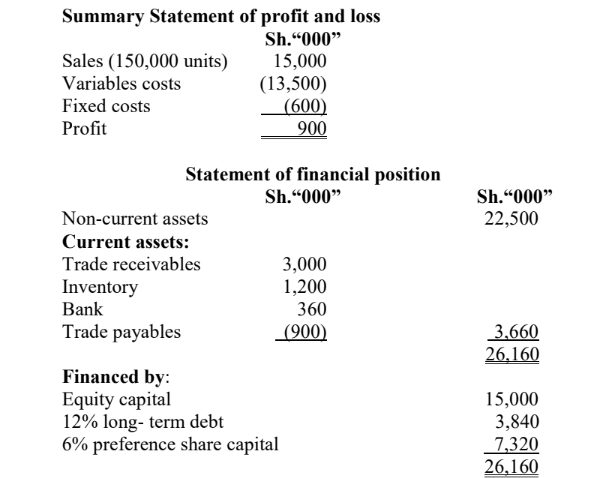THURSDAY: 8 December 2022. Afternoon Paper. Time Allowed: 3 hours.
Answer ALL questions. Marks allocated to each question are shown at the end of the question. Show ALL your workings. Do NOT write anything on this paper.
QUESTION ONE
1. Ethical responsibilities arise not as a result of legal requirements but as a result of moral imperative for companies to operate in an ethical and fair manner.
In light of the above statement, summarise SIX elements of business ethics in management of companies. (6 marks)
2. Highlight FOUR factors that influence the choice of debt finance by a company. (4 marks)
3. Your client, Alfred Otieno, wishes to invest Sh.500,000 for two years (with interest compounded) but with the right to withdraw at a moment’s notice. The following investment options are available:
Option I: Invest with Nyumba Building Society currently offering an interest rate of 14% per annum after tax with interest paid half yearly.
Option II: Invest with Kijiji Bank Ltd. at an interest rate of 17% per annum with interest paid annually.
Option III: Invest with Faida Bank Ltd. which is offering 16% per annum, interest paid every three months.
Required:
Using suitable computations, advise your client on the best investment option he should consider. (6 marks)
Calculate the effective rate of interest for option I. (2 marks)
Identify TWO situations that could affect your recommendation in (c) (i) above. (2 marks)
(Total: 20 marks)
QUESTION TWO
1. Dopco Ltd. has provided the following summary of statement of financial position for the year ended 30 September
2022:


Required:
Determine the value of each ordinary share using the Net Asset value basis of valuation. (5 marks)
Outline THREE reasons for valuing securities of a company. (3 marks)
2. The following information relates to security X and security Y returns for the year 2021:

Required:
Determine the expected returns for security X and security Y. (2 marks)
Determine the standard deviation for each security. (4 marks)
Determine the covariance between security X and security Y. (4 marks)
Determine the correlation coefficient between security X and security Y. (2 marks)
(Total: 20 marks)
QUESTION THREE
1. Identify FIVE ways to achieve personal financial freedom. (5 marks)
Baraka Traders Ltd. has a minimum cash balance limit of Sh.100,000. The standard deviation of the daily cash flows
is Sh.25,000. The interest rate of the marketable securities is 9.2% per annum.
The transactional cost for each sale or purchase of security is Sh.200.
Assume a 365-day year.
Required:
Using Miller-Orr cash management model, determine:
Target cash level. (2 marks)
Upper cash limit. (2 marks)
Average cash balance. (2 marks)
The spread. (1 mark)
3. Jawabu Ltd. is evaluating a project with an expected useful life of 6 years and the following characteristics:
1. Fixed capital investment of Sh.4,000,000.
2. The initial investment in net worth working capital is Sh.400,000.
At the end of each year, net working capital must be increased so that the cumulative investment in net working capital is one-sixth of the next year projected sales.
3. The fixed capital is depreciated on cost at the following rates: 30% in year 1, 35% in year 2, 20% in year 3,
10% in year 4, 5% in year 5 and 0% in year 6.
4. Sales are Sh.2,400,000 in year 1, they grow at 25% annual rate for the next two years and then grow at 10%
annual rate for the last three years.
5. Fixed cash operating expenses are Sh.300,000 for year 1-3 and Sh.260,000 for year 4-6.
6. Variable cash operating expenses are 40% of sales in year 1, 39% of sales in year 2 and 38% of sales in year 3 – 6.
7. The corporate tax rate is 30%. If taxable income on the project is negative in any year, the loss will offset gains elsewhere in the corporation, resulting in a tax savings.
8. Fixed capital investment will be sold for Sh.300,000 when the project is complete and recapture its cumulative investment in networking capital. Income taxes will be paid on any gains on disposal.
9. The project required rate of return is 12%.
Required:
Determine the suitability of the project using the Net Present Value (NPV) method. (8 marks)
(Total: 20 marks)
QUESTION FOUR
1. Explain THREE factors that influence the dividend policy of a firm. (6 marks)
2. Outline FIVE factors that influence the price of a listed company’s share. (5 marks)
3. The following are the summary statement of profit and loss and statement of financial position for Miranda Ltd. for
the year ended 31 October 2022.

Additional information:
1. Return on investment (ROI) is 4.8%.
2. All sales are on credit and the company operates a very strict credit control system.
3. A suggestion has been made that a relaxation of credit policy would increase sales by 40%, if the company were to introduce a 2% discount (at present no discount is given) on accounts paid within 10 days.
4. It is envisioned that 70% of the customers would take advantage of the discount and the average collection period of the remainder would be half of what it is at present.
5. Bad debts would remain at 2% of firm’s credit sales.
6. Investors required rate of return is 10%.
Assume 360 days in a year.
Required:
The current average collection period. (1 mark)
The new level of profits after change in credit policy. (6 marks)
Explain the effect of the new level of investment in account receivable. (2 marks)
(Total: 20 marks)
QUESTION FIVE
1. Explain the term “crowdfunding”. (2 marks)
Explain TWO benefits of digital finance as part of financial inclusion. (2 marks)
2. Discuss THREE activities that are prohibited under Islamic Finance. (6 marks)
3. Kanga Ltd. expects earnings before interest and tax (EBIT) of Sh.7,500,000 in the current financial year. The company pays interest of 8% per annum on a long term loan of Sh.25,000,000.
The company has 1,200,000 ordinary shares and the corporate tax rate is 30%. The finance manager is currently
examining two options:
Option I: A case where earnings before interest and tax (EBIT) is 20% more than expected.
Option II: A case where earnings before interest and tax (EBIT) is 20% less than expected.
Required:
Determine the earnings per share (EPS) under option I and option II and where there is no change in the expected earnings before interest and tax (EBIT). (6 marks)
Degree of financial gearing for option I and option II. (4 marks)
(Total: 20 marks)
